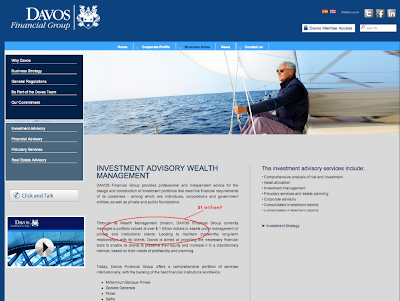Back in April, in the course of my research into the Boliburgeoisie, I came across a claim, a bold one, that left me gobsmacked: DAVOS Financial Group -owned by David Osio- was stating in its website that it had a «portfolio valued at over $1 trillion in assets under management of private and institutional clients.» One trillion dollars. Wow. I made sure to take a screen shot and then tweeted: «David Osio claims his DAVOS bank has $1 trillion (?) under management. Is that where the bulk of Vzla’s missing funds are? @davosobserver»

The reply was swift and also came through Twitter (as seen on left). DAVOS Financial Group said that their site «had been hacked by unscrupulous hands…» However archive.org paints a different picture, providing evidence that the hack lasted almost a year: that is to say, DAVOS did not realize that its website had been «compromised» since -at least- August 2012, as shown here. The $1 trillion claim was placed there by «unscrupulous hands» of hackers and no one at DAVOS had noticed, until I tweeted about it.
But DAVOS’ oddities don’t end there. In different literature to drum up new business, it claims that it has $2.8 billion under management. That’s quite a discrepancy, no? From $1 trillion to $2.8 billion? In yet a different publication, DAVOS claims to «operate… under the supervision of international organizations, such as: ARIF (Switzerland), FINRA and FREC (United States), CNV (Panama).»
ARIF of Switzerland has no record of DAVOS Financial Group, but rather an entry for asset manager D. Société financière (Suisse) SA, which DAVOS claims is its «Swiss holding». Official Swiss records show that David Osio’s control over D. Société has been revoked.
FINRA has also very interesting information on DAVOS. There are two individuals registered as investment advisors for DAVOS: Andres Coles and Adam Stramwasser. A search for DAVOS, as institution, returns two records, one for Florida and one for New York. But in the application for investment adviser registration there’s question O, which reads: «Did you have $1 billion or more in assets on the last day of your most recent fiscal year?» In both cases DAVOS answered in the negative. Therefore, DAVOS either misleads its potential customers in its prospectus, press releases and website or it misleads in its applications to the U.S. Securities and Exchange Commission.
When I asked DAVOS which financial authority regulated its activities, it replied through Carmen Monasterio:
In response to your question, please note that Davos Financial Group operates as a financial advisory firm in regulated jurisdictions, and exclusively with front-line European and USA financial institutions. As a licensed and regulated company our compliance polices are very strict, following the best practices, and under the permanent scrutiny of regulators of Switzerland, Europe and The United States. Our KYC procedures follow the highest standards, equal to those of our correspondent banks in Europe and the USA. Our executives are regularly instructed and certified in AML by FIBA and other prestigious institutions.
I am sure DAVOS’ AML compliance policies in Venezuela are «very strict», just like those of HSBC in Mexico. FIBA, which is a trade association and not an official financial watchdog, refused recently to provide information related to accreditations allegedly earned by DAVOS Financial Group staff, sending an unsigned reply to an information request I sent.
I understand DAVOS operates in different jurisdictions, so would the $1 trillion, or the $2.8 billion, refer to all assets in all jurisdictions? Further, why would DAVOS go to the trouble of registering in Florida and New York and have a couple of investment advisors registered in the U.S. to then place a warning in its website saying their services are not to be considered by U.S. residents?
David Osio is a U.S. resident as far as I understand, he has even donated to Ileana Ros-Lehtinen and Barack Obama campaigns. Is his company paying taxes on less than $1 billion, $2.8 billion, or $1 trillion?
Tomado de Davos Financial Group bogus claims
